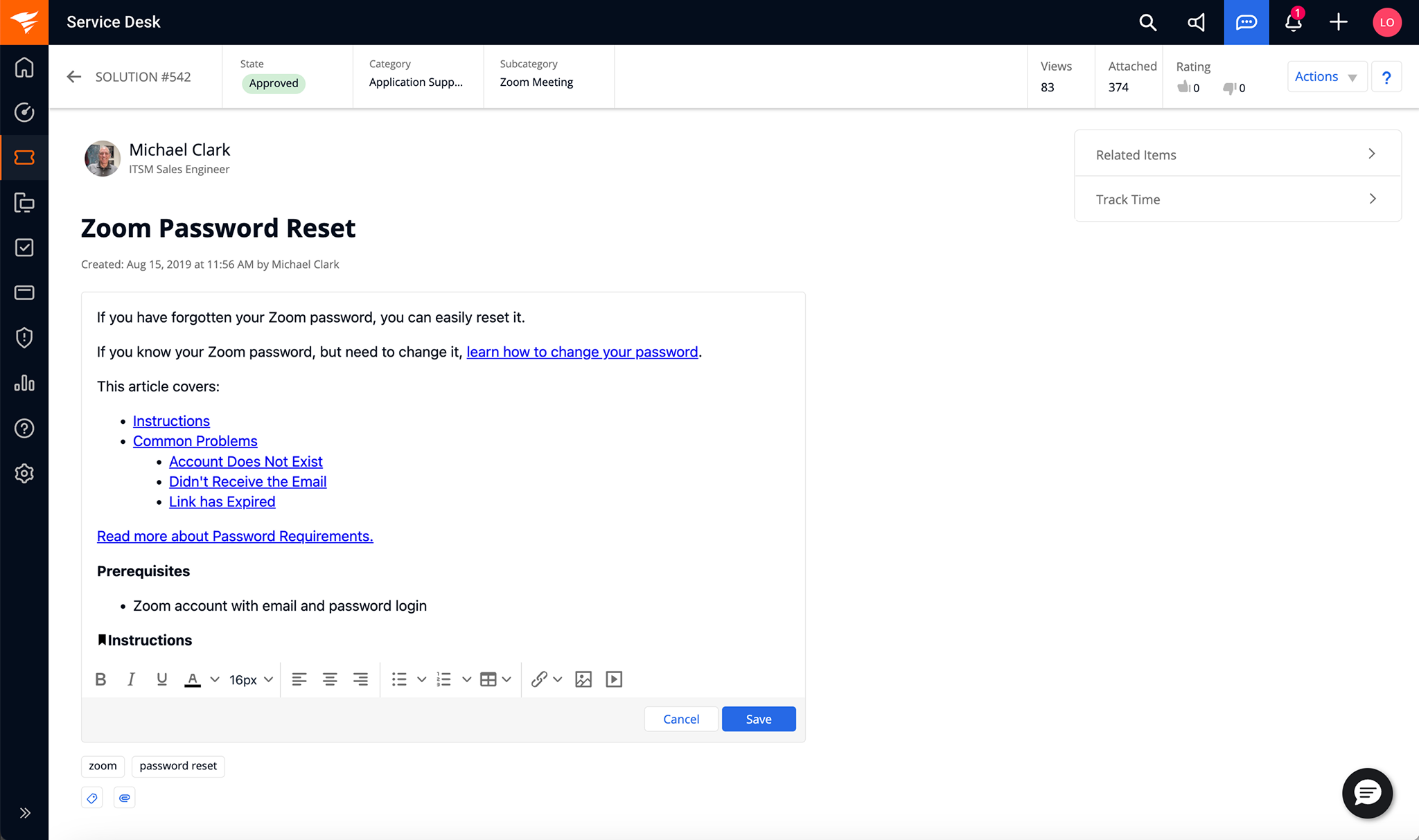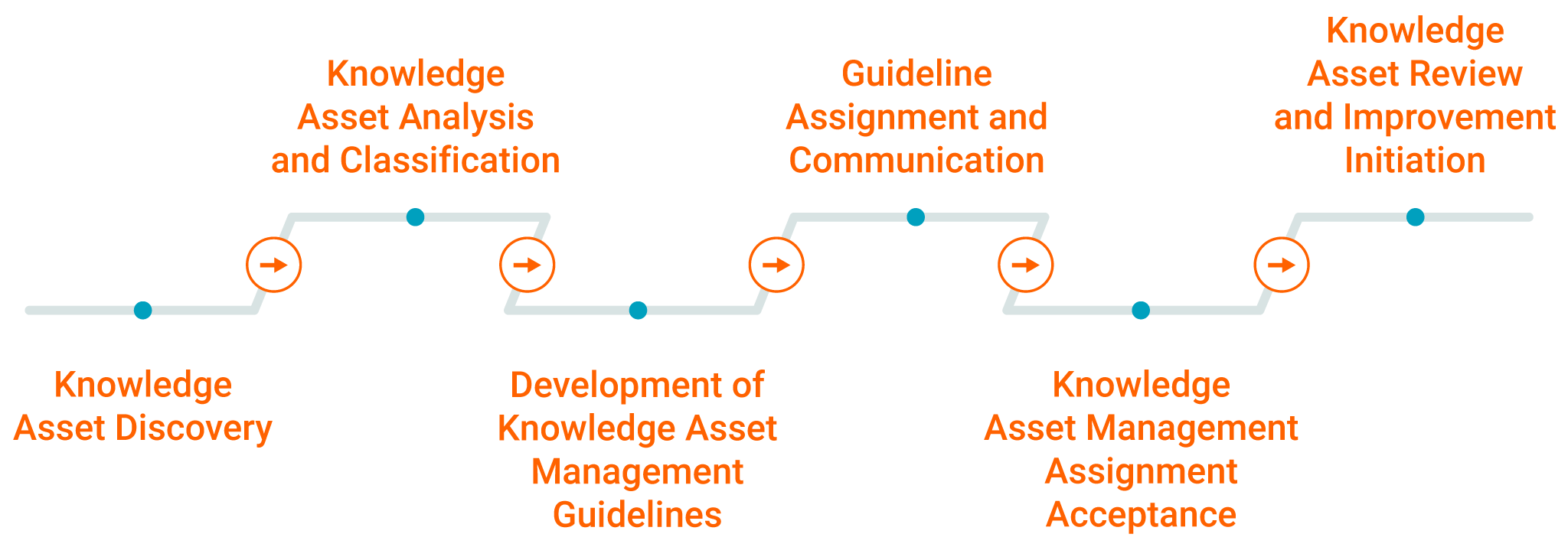Implementing ITSM Knowledge Management: A Best Practice Guide
The digital age triggered an explosion of knowledge, which has kept IT teams on their toes and trying to keep up. From DevOps to SRE, gen AI to crypto, acquiring, disseminating, and applying the latest knowledge is a strategic imperative for any modern organization at the forefront of technology evolution.
The volume of knowledge within modern organizations adds complexity to the challenge. According to ITIL 4, knowledge has no intrinsic value. Business outcomes for IT teams, users, and stakeholders determine knowledge value. Effective knowledge management transforms information and organizational intellectual capital into persistent value for employees and service consumers. By establishing the right processes, systems, and tools, organizations can ensure that the knowledge is readily available to support business initiatives and operational activities. This knowledge can be generated internally or obtained from external sources.
ITSM provides teams with a framework to streamline effective knowledge management and empower teams to leverage proven best practices as they scale knowledge throughout the organization. This article will explore five practical ITSM knowledge management best practices to help modern IT teams acquire and manage valuable knowledge.
Summary of ITSM knowledge management best practices
The table below summarizes the five ITSM knowledge management best practices this article will explore.
Best Practices | Description |
Understand the organization’s knowledge assets | Identify and catalog the knowledge that is most relevant to the organization’s mission and strategy |
Build an organizational-wide knowledge-sharing culture | Make the sharing of knowledge part of the organization’s DNA, objectives, and behaviors |
Develop a formal process for managing the knowledge lifecycle | Establish a formal approach for the management of new and existing knowledge within the organization |
Invest in modern tools for presenting and managing knowledge | Adopt relevant technologies for the effective management of access and updates to organizational knowledge |
Track metrics on knowledge usage and updates | Monitor, review, and improve the use of knowledge and associated value creation |
Five proven ITSM knowledge management best practices
Each section below details a proven ITSM knowledge management practice that can help modern IT teams improve and scale knowledge throughout an organization.
Understand the organization’s knowledge assets
The SECI model of knowledge management defines two types of knowledge:
- Explicit knowledge: Information from books, databases, and other knowledge sources that can be transferred to others, codified, assessed, verbalized, and stored.
- Tacit knowledge: Knowledge based on experience, values, capabilities, and skills that is difficult to transfer to others, express, codify, or assess.
Many organizations have started to realize that knowledge is an organizational asset that needs to be managed. According to the ISO 30401 standard for knowledge management systems, knowledge needs to be developed, retained, shared, adapted, and applied so that employees can make effective decisions and take aligned actions based on the experience of the past and new insights into the future. When an organization seeks to understand its knowledge assets, it primarily focuses on explicit knowledge. This includes documented policies and processes, product and system manuals, troubleshooting guides, release notes, ITSM records, and FAQ.
Teams should log and audit organizational knowledge and associated knowledge management systems across all business functions. These practices enable the identification of critical knowledge assets and support effective knowledge management. A knowledge register or reference that maps knowledge assets stored in various formats and locations can be a good starting point for teams beginning their ITSM knowledge management journey.
Once knowledge assets are identified and logged, they can then be characterized based on their importance. The ITIL 4 knowledge management practice guide identifies three dimensions, criticality, rarity, and appropriability.
- Critical knowledge assets significantly impact an organization’s performance and strategy realization. Examples can include business strategies, product configuration or pricing, and customer insights.
- Rare knowledge assets are hard to find or replace in the event of a loss. For example, some employees hold significant knowledge through having years of experience in the organization’s history.
- Appropriate knowledge assets can be transferred from one organization to another without a significant loss in value. This can include knowledge related to outsourced services or systems.
Mapping knowledge requirements to business strategic objectives is a popular tactic for determining the importance of knowledge assets. Knowledge management should be a critical success factor when strategic goals are being developed. Prioritization of knowledge management at this stage informs knowledge asset prioritization and focuses organizational effort on effective ITSM knowledge management to support strategic goals.

Empower Your Users. Unburden Your Agents.
Transform your organization’s expertise into a powerful asset. Our knowledge management solutions help make it easy to capture, share, and access information.
Build an organizational-wide knowledge-sharing culture
Peter Drucker famously stated “Culture eats strategy for breakfast”, implying that buy-in from stakeholders is an essential ingredient for the success of any strategic initiative. Culture is critical to the effectiveness of knowledge management. The right culture of creation, sharing, and application starts with the understanding that there is a lot of hidden knowledge within individuals gathered over time. Therefore, the right atmosphere and influence are necessary to exploit and maximize this capability.
Executives must regularly communicate and demonstrate the proper knowledge management principles that drive collaboration and cooperation across the organization through transparency and easy access to requisite knowledge while creating a work environment that stresses the value and importance of sharing knowledge. Some of the guiding principles outlined in ISO 30401 include:
- Adaptive: Organizations should develop their own approach to knowledge management based on the needs and context.
- Shared understanding: Knowledge management should include interaction between people using content, processes, and technologies where appropriate.
- Environment: Knowledge is not managed directly, instead the focus is managing the work environment that nurtures knowledge creation, usage, and sharing.
Knowledge is a crucial source of value for organizations and serves their strategies, objectives, and needs. High-performance knowledge cultures encourage people to ask questions, challenge the status quo, learn and unlearn, consider alternate perspectives, and overcome fear of worry or judgment. Top management should embed culture through strategic initiatives. The balanced scorecard is an example of a strategic tool for defining objectives for knowledge creation and sharing under the fourth perspective of Learning and Growth. Examples of relevant business activities include:
- Training and mentoring plans
- Investments in knowledge IT tools
- Initiatives to reverse brain drain
A knowledge manager role should be assigned to oversee the process and drive the entrenchment of knowledge management culture. In addition, based on the context, teams should customize the process to address stakeholder needs, including satisfaction of existing organizational knowledge and future requirements and recommendations. For example, a product owner can be a Scrum team's knowledge manager.
Develop a formal process for managing the knowledge lifecycle
Formal ITSM knowledge management processes enable management to steer teams in the right direction concerning knowledge acquisition, usage, and maintenance. Well-defined processes set standards and ensure quality throughout the knowledge lifecycle, driving shared understanding and accountability.
ITIL 4 guidance gives us an example of a knowledge asset management process focused on the management of knowledge assets throughout their lifecycle, and their integration into the work environment. The inputs into this process are information assets used by the organization, information security policies, quality guidelines, and stakeholder feedback. The activities involved are:
- Knowledge asset discovery: The designated knowledge managers identify information assets within the organization. This activity is triggered by the introduction of new assets, feedback from users, requests from a stakeholder, or asset review findings.
- Knowledge assets analysis and classification: The identified knowledge assets are evaluated and classified according to the established organizational guidelines. If no applicable category is identified, this triggers an update to the guidelines.
- Development of knowledge asset management guidelines: The guidelines are developed/updated depending on the discovered knowledge assets. This includes appropriate ownership, assignment, access, security classification, and storage instructions.
- Guideline assignment and communication: When an applicable category is identified, the knowledge asset is assigned to an owner, and the assignment is communicated.
- Knowledge asset management assignment acceptance: The relevant knowledge owner accepts the knowledge assignment and deploys the knowledge per the guidelines. This includes training and awareness for stakeholders, and making the knowledge available through relevant repositories.
- Knowledge asset review and improvement initiation: The knowledge manager reviews metrics and stakeholder feedback related to knowledge usage and relevance and initiates required improvements, including updates, enhancements to repositories, and archiving of outdated/irrelevant knowledge.
Organizations must define and assign knowledge creation, maintenance, and review roles to ensure accountability and effective knowledge management. Key stakeholders include knowledge managers, owners, and subject matter experts. Teams can use a framework such as SFIA (Skills for the Information Age) to identify the relevant knowledge management capabilities required across different organizational levels. Such skills include creating, curating, organizing, sharing, and utilizing knowledge.
Invest in modern tools for managing access and updates to organizational knowledge
For modern IT, speed and agility are paramount to effectively respond to changing market conditions and user needs. With the amount of knowledge required increasing exponentially, ensuring that the organization has the right set of tools to manage knowledge across its lifecycle is necessary. Since knowledge is usually fragmented across various business functions, the right tools can enable organizations to mature by having holistic knowledge flows aligned to value streams.
Knowledge management tools come in a variety of shapes and forms such as databases, document management systems, content management systems, data warehouses, and data visualization tools. IT staff can establish their own user-friendly knowledge bases to address queries, solve technical issues, and support product development. Such systems can create, categorize, store, and correlate different knowledge assets and provide knowledge articles for those seeking solutions via self-service platforms. They also allow IT support teams to relate configuration information and troubleshooting knowledge with process records such as incidents and change requests and related configuration items such as servers and end-user devices.

A knowledge article sample in SolarWinds Service Desk
The rise of generative AI systems has ushered in a new dimension in knowledge creation and sharing. Organizations can leverage AI to speed up decision-making and facilitate faster execution of required actions by generating recommended information or steps for IT support staff to follow, including suggested responses to queries or workarounds for an incident. Gen AI tools are also useful in ITSM practices as they can generate summaries for meetings or information in a ticket. Virtual agents powered by Gen AI can also recommend knowledge articles to users accessing self-service, and chat with them to find out their needs. Organizations should train their adopted Gen AI systems on internal explicit knowledge but do so by having a robust curation process to ensure information fed into their Gen AI models is accurate, valuable, and updated. The risks of bias or hallucinations can result in a backlash from knowledge users. Hence, experts should regularly review information generated by Gen AI.
Teams should also configure knowledge management tools to comply with information security and data privacy policies. For example, a knowledge system may require process controls to ensure strict access management that restricts privileged access to designated knowledge managers responsible for curating and updating information within their domains. Critical knowledge such as intellectual property or product configurations should be tagged with the relevant security classification, and appropriate security controls such as access control, encryption, and secure transfer implemented.
Track metrics on knowledge usage and updates
The adage ‘what you can’t measure, you can’t improve’ is an essential principle in ITSM knowledge management. Strategic objectives related to learning and growth provide the basis for defining knowledge management KPIs relevant to driving excellence in ITSM and aligning with business strategy. COBIT 2019 provides examples of metrics that are relevant to knowledge management practices as outlined below:
- Percent of categorized information validated
- Percent of appropriateness of content types, artifacts, and structured and unstructured information
- Number of relationships identified among sources of information (tagging)
- Percent of stakeholder satisfaction with the organization and contextualization of information into knowledge
- Percent of available knowledge actually used
- Percent of knowledge user satisfaction
- Frequency of update
Measuring individual and team satisfaction with the organization’s knowledge systems is a critical undertaking that points to whether the prevailing knowledge management culture is effectively supported by the right processes and tools to achieve strategic objectives. When users cannot quickly and accurately find the required knowledge, they quickly write off organizational tools and switch to other knowledge acquisition and sharing methods, which may introduce risks as existing information security controls may not apply.
Knowledge culture is usually promoted through organizational initiatives to drive collaboration and knowledge-sharing through incentives and the deployment of associated technologies. These include rewards, continuous learning, intellectual property creation, and cross-functional collaboration. Organizations should track outcomes from such initiatives and communicate benefits and progress to stakeholders.
How to get started with ITSM knowledge management
Establishing a framework can be challenging when an organization lacks a preexisting knowledge management strategy. A good starting point is to assess the organization's current state of knowledge management. Ask questions such as:
- What knowledge do we possess?
- Where is it stored?
- Who uses it?
Such an assessment can help an organization pinpoint critical areas in IT service delivery that would greatly benefit from improved knowledge management practices, and raise the level of capability across different functions. In ITSM, teams can start with the IT service desk, where queries are handled. By building a process and establishing tools, valuable gains such as improved speed of response and resolution of handling issues can be used as a springboard for other functions to build upon.
Another challenge is that an organization has hundreds of knowledge articles scattered across multiple functions and maintained in various formats and tools. Teams may have their preferred approach to maintaining knowledge that may differ from others. This issue can be tackled by adopting a joint knowledge base that uses links to reference articles maintained in different repositories. Through organizational change plans, staff can learn the benefits of the centralized view and slowly adopt a common approach to documenting knowledge that leverages the capabilities of the knowledge base. Deploying Gen AI tools that can sift through the multiple knowledge repositories and offer a standard interface can also help with this challenge.
Last thoughts
Knowledge management is an underrated practice whose value is seldom understood unless there is a concerted effort from the organization’s leadership to make it part and parcel of the DNA and strategy. This takes significant work in building knowledge management processes, training and equipping staff, assigning oversight roles, deploying the right tools, and driving culture change. In the digital age, a sound knowledge-sharing culture is essential to building innovation and effectiveness within IT service management and the wider organization.
While knowledge management tools and systems offer significant value in managing access, availability, and maintenance of relevant knowledge, organizations must remain aware that the knowledge contained in such tools may not necessarily translate to value without a formal knowledge-sharing approach.
SolarWinds has worked with teams of all sizes, from small startups to giant enterprises, and has poured all that experience into its ITSM Maturity framework. The free, consultative tool is designed to help you figure out your current state, what you intend to achieve, and what tools you need to get there.

The interactive SolarWinds ITSM Maturity Model
To analyze your team’s ITSM maturity, check out our free interactive ITSM maturity model.
Ready to create ITSMagic for your organization?
